Reserve Bank of Australia Annual Report – 2022Communication and Community Engagement
The Reserve Bank is committed to being open, transparent and accountable in all its communication. The Bank’s staff across Australia work to understand community priorities and concerns and, in turn, explain the Bank’s policies and decisions. The Bank engages with the community in a range of ways, including via a longstanding regional and industry liaison program and a public education program. It consults with businesses, consumer groups and payments industry participants on issues in payments policy. The Bank communicates its policy decisions, and the context in which these are made, through publications and speeches. The Bank participates in parliamentary hearings and responds to public enquiries. It supports academic research, publishes a broad range of statistics and operates a museum where visitors can discover the history of Australia’s banknotes and economic development.
Publications and speeches
The Reserve Bank’s communication about its policy decisions, analysis and operations is primarily through publications (including media releases) and speeches. Announcements about monetary policy decisions are made shortly after each Reserve Bank Board meeting and minutes are released two weeks later. A media release is published following each Payments System Board meeting, outlining issues discussed at the meeting and foreshadowing any documents to be released by the Bank.
Public appearances provide an opportunity to communicate the Bank’s analysis of economic and financial developments and how they have influenced monetary policy decisions, as well as to respond to questions in a public forum. During 2021/22, the Governor spoke at a number of public events to provide an update on monetary policy and answer questions from the media and financial markets participants. In addition, there were two media and market briefings held on the days of the Board meeting when there was significant new information to communicate. The first was in November 2021 when, it addition to providing an update on the economy and monetary policy, the Governor explained the Reserve Bank Board’s decision to discontinue the yield target and the nature of the Bank’s forward guidance. Following the May 2022 Board meeting, the Governor explained why the Board had decided to increase the cash rate target from the emergency settings that were put in place to support the Australian economy during the COVID-19 pandemic. In June 2022, the Governor appeared on the ABC’s 7.30 program to further explain the Board’s decisions and the economic and financial outlook.
As is the case for all of the Governor and Deputy Governor’s public appearances, audio of each address was broadcast live, including the question and answer sessions with participants, and transcripts were published on the Bank’s website.
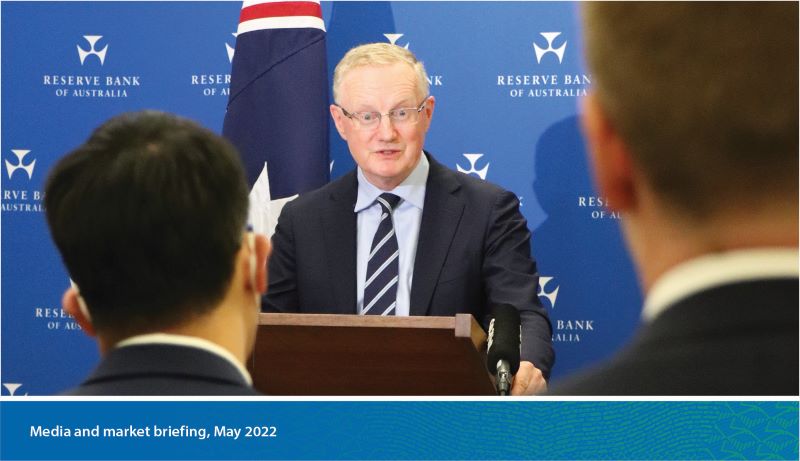
In addition to the above, during 2021/22 the Governor, Deputy Governor and other senior staff gave 39 public speeches on various topics. The gradual lifting of restrictions in place during the pandemic saw speeches increasingly being given in person as well as online. Senior staff also participated in public panel discussions and a number of parliamentary hearings. There were speeches on monetary policy, the changing economic outlook, payments and climate change. These speeches, the associated question and answer sessions and the panel discussions were published on the Bank’s website in audio and text to facilitate transparency and accessibility.
The Reserve Bank explains its analysis through a number of regular publications:
- the quarterly Statement on Monetary Policy provides information about the Bank’s assessment of current economic and financial conditions, along with the outlook for economic activity and inflation in Australia
- the Financial Stability Review, published semi-annually, provides a detailed assessment of the condition of Australia’s financial system and potential risks to financial stability
- the quarterly Bulletin contains analysis of a broad range of economic and financial issues, as well as aspects of the Bank’s operations; during 2021/22, 33 articles were published in the Bulletin.
The Reserve Bank publishes information on its website, which continued to provide new and refreshed content. Followers of the Bank’s social media accounts on Twitter, LinkedIn, Facebook and Instagram have grown to over 179,000, while the number of subscribers to a new email alert service is around 14,600. Visitors to the Bank’s website also made use of the RSS feeds, which provide alerts about data updates, media releases, speeches, research papers and other publications, including those related to Freedom of Information requests.
Regional and industry liaison
Staff in the Reserve Bank’s regional and industry liaison team – which operates from four state offices around Australia (in Adelaide, Brisbane, Melbourne and Perth) and the Bank’s Head Office in Sydney – work together to conduct the Bank’s liaison program. Liaison staff meet regularly with businesses from all sectors of the economy, associations, governments and community organisations from across the country, including in regional areas. Around 780 liaison meetings were conducted in 2021/22. While staff were limited in their ability to visit contacts in person over much of the past year, engagement continued via telephone and videoconference meetings. However, towards the end of the year, there was a return to more face-to-face meetings; liaison staff also took the opportunity to visit a few regional centres, with additional regional visits undertaken in the early part of 2022/23.
Timely information provided by liaison contacts helps the Bank to monitor trends in the Australian economy, industry-specific developments and assess the effect of unusual events, such as the COVID-19 pandemic and natural disasters. This information is used in conjunction with data from official and other sources, allowing the Bank to better understand the issues affecting businesses and the economy in general.[1] The timeliness of information gathered from the Bank’s liaison program has been particularly valuable during the COVID-19 pandemic, enabling the Bank quickly to assess the impact of containment measures and other disruptions to the Australian economy prior to it being reported in official data sources. The liaison program has also provided valuable information about the effect of the pandemic on businesses and households and their responses, the nature and evolution of the economic recovery, and the effectiveness of monetary and fiscal support measures. Summary de-identified messages from liaison about the impact of the pandemic are regularly shared with the Reserve Bank Board, senior management and other government agencies.
Broad messages from liaison inform the Reserve Bank Board’s policy decision-making and are communicated to the public through the Bank’s regular statements and reports, as well as speeches by senior staff. Liaison information is also regularly drawn upon in the Bulletin and the Statement on Monetary Policy. In 2021/22, this included the availability of labour and wage-setting behaviour, supply chain disruptions, conditions in the commercial property and construction sectors. A regular dedicated summary of liaison messages will be included in the Statement on Monetary Policy from the November 2022 publication.
Staff in the state offices play an important role in the Bank’s communication with members of the public, as they are well positioned to hold discussions with a broad cross-section of the community. In 2021/22, state office staff gave around 10 presentations to members of the community, including at schools, business roundtables and regional chambers of commerce. In addition, Bank employees presented summaries of the Statement on Monetary Policy and the Financial Stability Review during the year to around 250 participants in the liaison program. All of these presentations were conducted virtually, enabling contacts from both metropolitan and regional areas to attend.
As noted in the chapter on ‘Governance and Accountability’, the Reserve Bank Board would usually meet in state capitals other than Sydney on a regular basis, and a dinner would be held with members of the local community, including representatives and leaders from politics, business, the public sector, and educational and community organisations. However, in 2021/22 no community dinners were held owing to the containment measures and domestic travel restrictions associated with COVID-19. Planning for the Board to meet in state capitals other than Sydney is under way for 2022/23, with the first of these meetings to be held in Hobart in November 2022.
The Reserve Bank convened its annual Small Business Finance Advisory Panel in July 2022. The Panel, which was established in 1993, discusses issues relating to the provision of finance and the broader economic environment for small businesses. Membership of the panel is drawn from a range of industries across the country. The Panel provides a valuable source of information on financial and economic conditions faced by small businesses. An article drawing on the Panel’s discussions in 2021 and other sources of information on small business finance appeared in the September 2021 Bulletin,[2] and the latest panel discussion and sources of information is covered in the September 2022 Bulletin.[3]
Consultations and public enquiries
The Reserve Bank maintains engagement with a wide variety of groups to inform its policy and operational activities. Senior Bank staff meet regularly with representatives of various domestic and international official agencies, business groups and financial market participants to discuss economic, financial and industry developments.
In October 2021, the Bank published the conclusions paper from the comprehensive Review of Retail Payments Regulation, which began in late 2019.[4] The paper set out various policy actions decided by the Payments System Board, which are expected to contribute to a more efficient and competitive payments system. The Bank consulted extensively with a wide range of stakeholders throughout the Review.
The Reserve Bank held two meetings of its Payments Consultation Group in 2021/22. The Group, which was established in 2014, is a structured mechanism for representatives of various users of the payments system (consumers, merchants, other businesses and government agencies) to convey their views on payments system issues as an input to the payments policy formulation process. More details on the activities of this group are provided in the Payments System Board Annual Report 2022.
Staff from the Payments Settlements Department continued to conduct regular liaison meetings with Reserve Bank Information and Transfer System (RITS) members and industry groups, such as the Australian Payments Network (AusPayNet). Staff also participated in various industry forums, including AusPayNet’s High Value Clearing System Management Committee. A senior staff member sits on the Board of AusPayNet and another senior staff member sits on the Board of New Payments Platform Australia Limited (NPPA), the company established to build and operate the NPP. Staff from the Payments Settlements and Banking departments represent the Bank on NPP operating committees. Participation in these groups, and a number of other industry forums, helps the Bank to remain well informed about developments in these areas and contribute to innovations in the banking and payments industry.
The Reserve Bank sponsors and provides the secretariat to the Australian Foreign Exchange Committee (AFXC). The AFXC is a member committee of the Global Foreign Exchange Committee (GFXC), of which former Deputy Governor Guy Debelle was the Chair until December 2021. During 2021/22, the AFXC sought to ensure the adoption of the updated FX Global Code within the Australian market and contributed to further materials developed by the GFXC to promote wider adherence to the principles of the Code (see chapter on ‘International Financial Cooperation’).
During the year, the Reserve Bank received approximately 2,800 public enquiries on a broad range of topics, including monetary policy, the economy, financial markets and regulation of the payments system. Responses were provided to the majority of enquiries received by the Bank. Staff from Note Issue Department also continued their engagement with industry and members of the public in relation to the new banknote series (see chapter on ‘Banknotes’).
Research
The Reserve Bank publishes the results of longer term research conducted by staff in the form of Research Discussion Papers (RDPs), which stimulate discussion and comment on policy-relevant issues. The views expressed in RDPs are those of the authors and do not necessarily represent those of the Bank. During 2021/22, seven RDPs were published on a range of topics in the Bank’s areas of interest, including: Australian household liquidity and spending; limits on mortgage products; the effect of bond purchases; the effect of corporate sentiment on investment; and extensions to the Bank’s Macroeconomic Model. Reserve Bank staff also published their research in various external journals, including the Journal of Econometrics, the Australian Economic Review and the Econometrics Journal.
Research undertaken at the Reserve Bank is frequently presented at external conferences and seminars. In 2021/22, Bank staff presented both in person and virtually at a number of conferences and institutions in Australia and overseas, including the International Association for Applied Econometrics Conference, the Bank for International Settlements, Macquarie University, Sydney Macro Reading Group, the IFC Workshop on Data Science in Central Banking, Boston University, the Monetary Authority of Singapore’s Golden Jubilee Conference and the Australian Treasury Macroeconomic Group Seminar.
The Reserve Bank hosts regular conferences to foster interaction between academics, central bankers and other economic practitioners on topical policy issues. After a number of years of disruption owing to the COVID-19 pandemic, conferences returned to being held in person in 2022. The Bank’s annual conference for 2022 was held in late June on the topic of ‘The Causes, Challenges and Consequences of the Low Interest Rate Environment’. The annual Macroeconomic Workshop was held in May, following the reopening of the refurbished H.C. Coombs Centre. Draft papers from the conference and workshop are available on the Bank’s website. The Bank also co-hosted a conference with the Australian Bureau of Statistics in March.
During 2021/22, the Reserve Bank hosted a number of policymakers from domestic and overseas institutions, such as the International Monetary Fund, the Bank of England and the Federal Reserve Bank of New York, as well as academics from a range of universities, including the University of Maryland, Harvard, Dartmouth, the University of Western Australia and the University of Melbourne. Due to the pandemic, the majority of these visitors presented seminars virtually at the Bank. International presenters of note included Lars Svensson and David Blanchflower.
The Reserve Bank sponsors economic research in areas that are closely aligned with its primary responsibilities. This sponsorship includes financial support for conferences, workshops, data gathering, journals and special research projects, and encompasses areas of study such as macroeconomics, econometrics and finance.
In 2021/22, the Bank continued its longstanding contribution towards the cost of a monthly survey of inflation expectations undertaken by the Melbourne Institute of Applied Economic and Social Research at the University of Melbourne. The Bank also maintained its contribution to a quarterly survey of union inflation and wage expectations undertaken by the Australian Council of Trade Unions.
The Bank continued to contribute to funding the International Journal of Central Banking, whose primary objectives are to disseminate first-class, policy-relevant and applied research on central banking and to promote communication among researchers both inside and outside central banks. The Bank also provides financial support to the Group of 30’s program of research into issues of importance to global financial markets.
The Bank provides financial support to the Australian Research Council Centre of Excellence in Population Ageing Research (CEPAR), based at the University of New South Wales. A senior official of the Bank sits on the Advisory Board of CEPAR.
The Reserve Bank makes a financial contribution to a number of conferences in economics and closely related fields. In 2021/22, these conferences included the University of Wollongong’s Labour Econometrics Workshop, the University of New South Wales’ Australasian Finance and Banking Conference, the University of Sydney’s First Women in Macroeconomics Workshop, Murdoch University’s National Indigenous Business Summer School and the Economic Society of Australia’s Australian Conference of Economists. The Bank continued its sponsorship of the Economic Society of Australia’s Central Council for the third year. The three-year sponsorship helps to build and strengthen the profession and the debate on economic issues.
In addition, in 2021/22 the Reserve Bank renewed its corporate membership of the Centre for Independent Studies, the Committee for Economic Development of Australia, the Ethics Alliance, the McKell Institute and the Lowy Institute for International Policy. The Bank has provided in-kind support for the Grattan Institute by seconding a staff member to the Institute during 2021/22. The Bank is also an associate member of the South East Asian Central Banks Research and Training Centre.
In conjunction with the Australian Prudential Regulation Authority (APRA), the Reserve Bank has continued to sponsor the Brian Gray Scholarship Program, initiated in 2002 in memory of a former senior staff member of the Bank and APRA. Two scholarships were awarded under this program in 2022. The cost to the Bank of this scholarship was $15,000.
The total value of support provided for research and education in 2021/22 was $364,397.
Education
A key part of the Reserve Bank’s community engagement is our relationship with students and educators, with a dedicated team coordinating the efforts of staff across the Bank to deliver a public education program. The main focus of the program is economics education at senior high school, although educational activities are also undertaken for different stages of learning (both at school and university). The program is delivered in person and online, with additional online resources developed to cater for remote learning needs during the pandemic.
The Reserve Bank’s commitment to economics education is motivated by the importance of economic literacy in the community and our concerns about the falling size and diversity of the economics student population. Nationally, the number of high school students studying economics in Year 12 has fallen by around 70 per cent since the early 1990s – with fewer schools (particularly government schools) offering economics. There has also been a significant fall in diversity over this period, with lower participation by females and students from schools that are culturally diverse or located in lower income areas. A similar pattern in economics enrolments is evident at university. To help address these issues, the Bank has been providing practical support by creating widely accessible resources that are aligned with curricula, giving presentations to students and offering professional development opportunities to educators. We have also been conducting research to identify how best to direct our efforts to increase engagement with economics and diversity among its student body.
A key feature of the education program is the delivery of talks to students by the Reserve Bank’s Ambassadors – the nearly 50 Bank economists who are trained to engage directly with students. The Ambassadors work closely with staff in the Bank’s state offices, who also participate in educational talks and help ensure they are available to students across the country. Talks are given to individual classes (in person and online) as well as at multi-school events in the form of webinars and in-person student conferences. The talks range from explanations of monetary policy, economic concepts and current economic conditions through to the benefits of studying economics. In total, around 7,900 students were reached during the year, of whom around 6,500 were high school students. Furthermore, using online delivery, presentations were given to students across the country, with greater geographic reach than in previous years – including to remote and regional areas.
Over the past year, the public education team expanded the school talks series to include talks for students in middle high school that introduce them to economics (as part of their commerce studies), so that they might choose economics in senior high school or university. These talks were accompanied by additional resources to support teachers in their delivery of economic content to these students.
Eighteen of the Bank’s core education resources were revised during the year to account for recent changes to the way that monetary policy is implemented and the recovery of the economy from the COVID-19 downturn. New text-based resources were also created, including an Explainer on the Non-Accelerating Inflation Rate of Unemployment (NAIRU). Videos were prepared after each quarterly Statement on Monetary Policy to provide an accessible update on current economic conditions for students and teachers. These videos complemented the talks given directly to students on this topic.
In terms of advocacy of economics, a six-part Explore Economics video series was produced to provide role models for students at both high school and university. Bank Ambassadors discussed the ‘big ideas’ in economics, the benefits of studying economics and their own study and career paths. The videos were used by educators to assist students with subject selection and career planning.
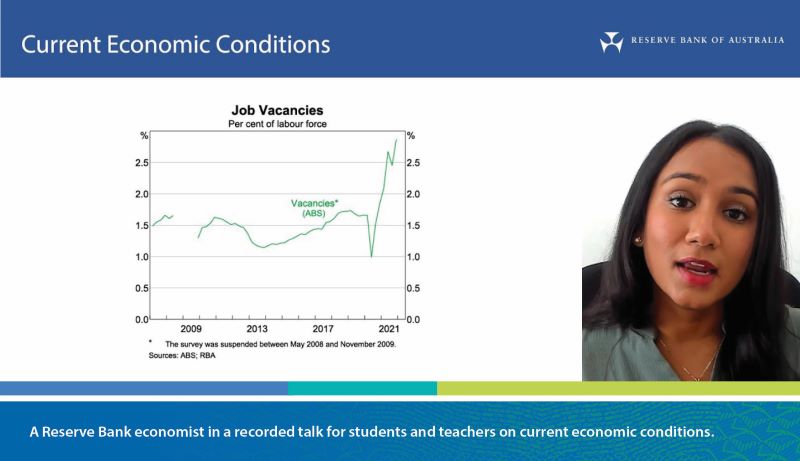
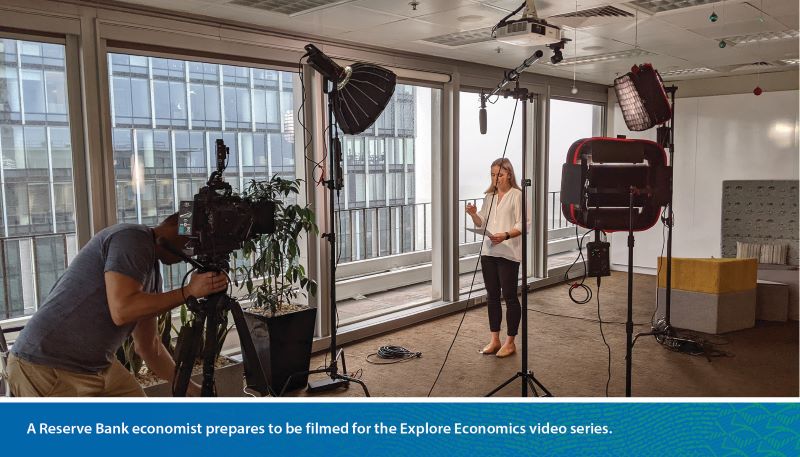
This past year saw the return of large-scale careers fairs, after a hiatus for much of the past two years because of the pandemic. As a result, in 2021/22 Reserve Bank staff participated in events attended by nearly 40,000 students. This provided an important opportunity for a large audience to gain exposure to economics and the Bank. Importantly, it allowed direct face-to-face engagement with students, with over 1,000 substantive discussions conducted with individual students about their subject and career choices.
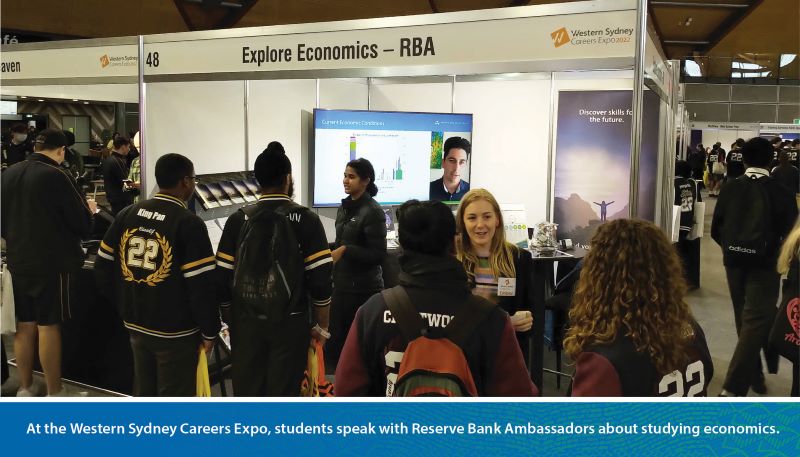
The Reserve Bank continued to support educators through professional development activities. We hosted an online version of the Teacher Immersion Event, which included addresses by the Governor and Assistant Governor (Economic), presentations by Bank staff on core economic topics, practical sessions on how Bank content could be delivered in the classroom and a Q&A session with the Deputy Governor. Teachers from across the country attended – including, for the first time, teachers from as far afield as Broome in Western Australia and Charters Towers in Queensland. The Bank also continued its Topical Talks series, in which educators attend a lecture given by a senior Bank staff member on a topical economic issue relevant to Year 12 and undergraduate students. Key sessions of Bank-hosted professional development activities were filmed and made available on the Bank’s website for a wider audience. In addition, Bank staff presented at various professional development events hosted by peak teaching bodies and other education service providers.
Further research was undertaken to guide the strategic direction of the public education program and evaluate its effectiveness. In particular, a randomised control trial was conducted of around 2,000 high school students to evaluate formally the effectiveness of the Bank’s school talks. This research identified that the talks improved both perceived and actual understanding of key economic concepts, and increased the confidence of students, including those who are less socially advantaged. The results were published in the December 2021 issue of the Bulletin.[5] Drawing on data from the same trial, another piece of research explored differences between a student’s perceived and observed proficiency in economics, finding that a significant ‘confidence gap’ existed for female students. This research was published in the March 2022 issue of the Bulletin, with the author invited to present at a number of external events.[6] In addition, there were ongoing surveys of teachers who participated in the Bank’s education activities to collect data for further research and program evaluation, as well as to identify their requirements for additional support.
The Educators Advisory Panel – which comprises external education experts who advise on the strategic direction of the Bank’s public education program – met twice virtually during the year to review the education program’s progress, with a particular focus on the lessons of the pandemic for future needs of students and educators.
Museum
The Reserve Bank’s Museum houses a permanent collection of artefacts and hosts periodic exhibitions. In the permanent collection, visitors can view the various types of money used in Australia before Federation through to the current innovative series of Next Generation Banknotes (NGB). Visitors can trace the evolution of the nation’s identity as expressed through its banknotes. They can also see the artwork used in banknote design, learn about how banknotes are made and discover their security features.
However, the Museum was closed for most of the past year because of the pandemic and construction work elsewhere in the building, which impeded access. Consequently, there was a shift to sharing its collections virtually, with new online exhibitions added to the Museum website along with a subscriber service and Museum newsletter. To enhance users’ engagement with the NGB series, an immersive audio experience – ‘Microprinting’ – was developed in which the microprint on each banknote was recited, with an accompanying soundscape, bringing its story to life.[7] While most readings were done by Museum staff, the audio format provided an opportunity to connect past and present histories through the voices of family members. The grandniece of David Unaipon read the microprint of the $50 banknote (on which he is represented), and the grandson of Sir John Monash read the microprint on the $100 banknote (on which he is represented).
Another online exhibition – ‘First Nations Peoples and Australian Banknotes’ – was devoted to the representation of First Nations peoples and culture on Australian banknotes.[8] It documented the transition from the depiction of First Nations peoples and culture as generic types towards awareness of their independent identities and histories. The exhibition addressed the issue of representation through the lens of banknotes – something most Australians use or see – to make a unique contribution to a neglected subject.
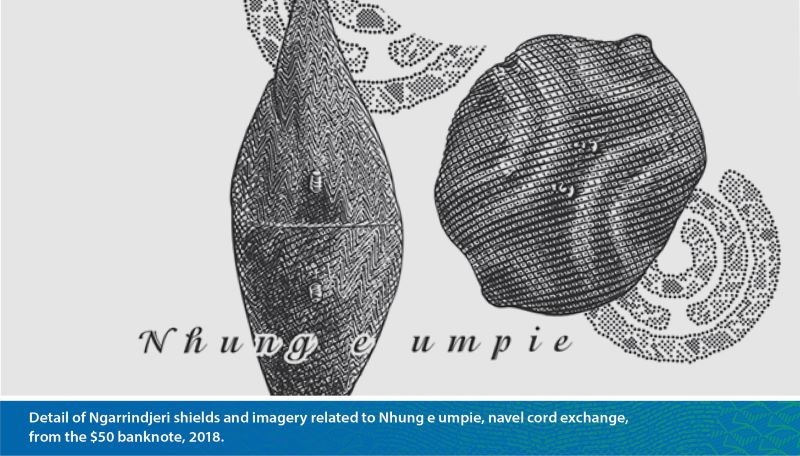
Additionally, a new feature on the representation of Queen Elizabeth II on Australia’s banknotes was released on the occasion of the monarch’s platinum jubilee.[9] As Queen Elizabeth II has been represented on each Australian banknote series issued during her reign, the exhibition highlighted the threads of continuity as well as progressive change that have characterised the evolution of the nation’s banknote designs.
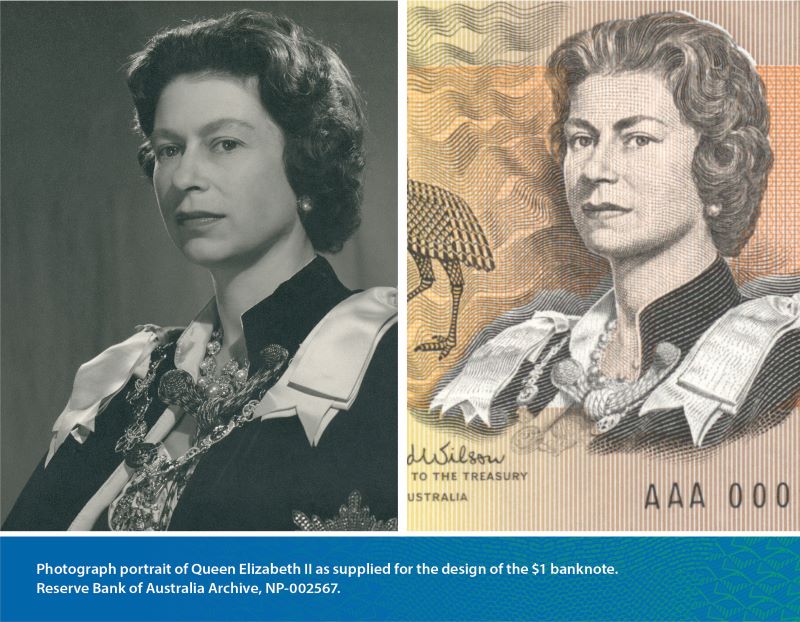
As well as adding online exhibitions, Museum staff conducted virtual school holiday activities in which younger students designed their own banknotes. The exercise introduced students to aspects of Australian history and financial literacy, to ensure they could understand the key features of the money they handle.
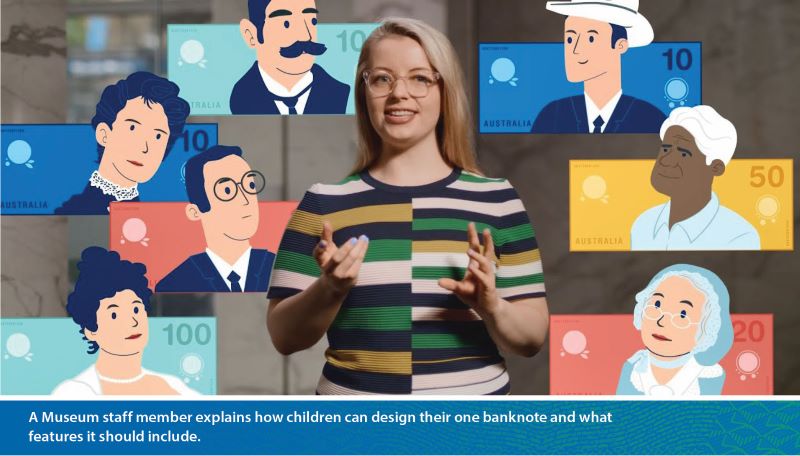
Archives
The Reserve Bank has a unique and rich archives collection. In addition to records about the Bank’s own operations, the archives contain records about Australia’s economic, financial and social history over nearly 200 years. The records predate the central bank as it is known today because the Reserve Bank had its origins in the original Commonwealth Bank of Australia, which had a central banking function and had absorbed other banks with a colonial history.
The Bank has been digitising its archival records and progressively releasing them to the public through our digital archive – Unreserved.[10] Unreserved enables users independently to research and download digital versions of archival records, learn about the nature and scope of the Bank’s archival collection, and lodge requests for information or assistance from the archivists. Since the launch of Unreserved in March 2021, there have been over 37,000 views of individual records or volumes of records via this platform.
Two additional releases of digitised archival records occurred during the past year, including records about:
- Reserve Bank Governors and senior personnel: The records of the early Governors and executives, most of which are from 1912–1948 and capture their responsibilities during world wars, the Great Depression and the 1918 pandemic.
- Research Department: The early economic analysis conducted by the central bank over the period 1911–1970, including records that form the basis of today’s Board papers and economic statements. Importantly, among these records is an unpublished book by Leslie Melville, the central bank’s first economist.
- Reserve Bank premises: Documents and photos relating to the purchase, construction and management of Reserve Bank buildings between 1912 and 1959. The photographic records also capture the development of the built environment in Australian towns and cities, as banking branches became more prominent and widespread .
Along with the records, the Bank published guides that provided researchers with information about the content of the series released, their historic context and an explanation of their significance. To showcase the value of the archival records, a Bulletin article explored the remarkable contribution of the Reserve Bank’s first economist to economics and public policymaking in Australia and abroad.[11]
While the pandemic has required the closure of the Reserve Bank’s Archives repository and public research room, the archivists were able to support most requests for information remotely by accessing digital versions of records that were then shared with researchers using the Bank’s secure external collaboration tool, RBA Box. They dealt with nearly 200 requests on a diverse range of topics, including family history, banknotes, sterling balances, colonial banking ledgers and images of Bank branches in the early 20th century. The archivists also continued to support the Bank’s Historian, Associate Professor Selwyn Cornish of the Australian National University, who is at an advanced stage of documenting the 1975–2000 period of the Reserve Bank’s official history.

Charitable activities
During 2021/22, the Reserve Bank made its 20th annual contribution of $50,000 to the Financial Markets Foundation for Children, which is chaired by the Governor. In September 2022, the will Governor deliver his sixth address to the Anika Foundation’s annual event to raise funds to support research into adolescent depression and suicide. This will be the 17th such event supported by the Bank.
The Reserve Bank supports several staff-led charitable initiatives, key among which involves dollar-matching staff payroll deductions (totalling $150,319 in 2021/22) organised by the Reserve Bank Benevolent Fund. The Fund supports a set of 15 recognised charities working in the areas of welfare, education, mental health, illness, disability, international medical aid and animal protection. The Bank also facilitates staff salary sacrificing under a Workplace Giving Program. Other staff-led initiatives over the year included:
- The Bank matched staff donations for the Benevolent Fund’s Christmas appeal for Foodbank Australia and Barnardos Australia.
- In lieu of the staff’s Children’s Christmas Party, the Bank made a donation to The Salvation Army in December 2021.
- Following the devastating impact of floods in New South Wales and Queensland, Bank staff raised $6,600 for the Australian Red Cross – Queensland and NSW Floods Appeal in a fundraising initiative organised by the Benevolent Fund.
- Reserve Bank staff participated in two volunteering activities in 2021/22 with Foodbank NSW & ACT and Foodbank Victoria.
The Reserve Bank’s contributions under these initiatives and other modest one-off donations in 2021/22 totalled $232,603.
Endnotes
See Dwyer J, K McLoughlin and A Walker (2022), ‘The Reserve Bank‘s Liaison Program Turns 21’, RBA Bulletin, September. [1]
See Black S, K Lane and L Nunn (2021), ‘Small Business Finance and COVID-19 Outbreaks’, RBA Bulletin, September. [2]
McCowage M and L Nunn (2022), ‘The Current Climate for Small Business Finance’, RBA Bulletin, September. [3]
RBA (2021), ‘Review of Retail Payments Regulation: Conclusions Paper’, October. [4]
Rickards P (2021), ‘Do RBA Talks Improve Student Outcomes?’, RBA Bulletin, December. [5]
Tan J (2022), ‘Exploring the Confidence Gap’, RBA Bulletin, March. [6]
RBA Museum, ‘Microprinting’. [7]
RBA Museum, ‘First Nations Peoples and Australian Banknotes’. [8]
RBA Museum, ‘Queen Elizabeth II’. [9]
RBA, ‘Unreserved’. [10]
See Cornish S (2021), ‘The Central Bank’s First Economist’, RBA Bulletin, December. [11]